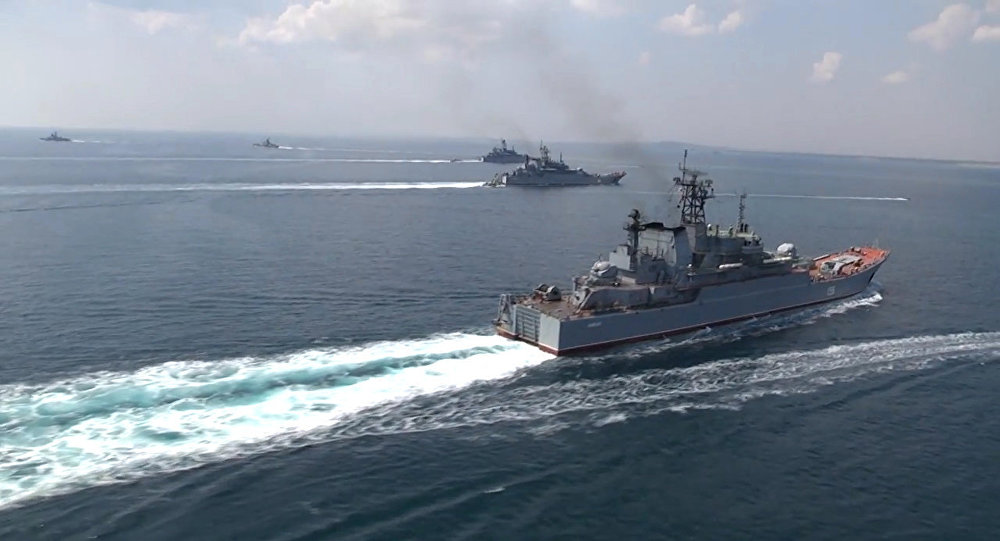
Russian Caspian Flotilla’s Capacity to Project Force Threatens Littoral States and Ukraine
Russian Caspian Flotilla’s Capacity to Project Force Threatens Littoral States and Ukraine
Moscow has been expanding the size and capabilities of its Caspian Flotilla. Most directly, this has implications for the Caspian littoral states and their development of oil and natural gas from the Caspian seabed. But it also impacts Ukraine and its coastline because the Russian authorities can and have transferred naval vessels from the Caspian to the Sea of Azov via the inland canals linking the two bodies of water. Russia began moving ships from the Caspian to the Azov Sea last spring; and over last several months, it has been deploying to the Caspian additional marines capable of attacking targets on land (see EDM, May 31; Vestnik Kavkaza, November 23).
Certainly, this naval expansion will have the greatest bearing on the Caspian littoral states of Azerbaijan, Iran, Kazakhstan and Turkmenistan (and for the restive republics of Russia’s North Caucasus as well). And this is particularly the case given Moscow’s current effort to rebase its Caspian Flotilla from Astrakhan, from where going to sea is sometimes more difficult, to Kaspiysk, Dagestan, where access to open waters is unimpeded and where the ships are closer to potential trouble spots (see EDM, July 17).
But Moscow’s ability to move ships from the Caspian to the Sea of Azov via inland Russian deep-water canals means that the buildup in the Caspian is not just about the projection of power in that region. It also affects naval deployments in the Sea of Azov, the Kerch Strait and the wider Black Sea. Thus, the beefing up of the landing capacity of the Caspian Flotilla is something Ukraine and its supporters need to worry about as well, given that ships filled with marines and landing craft can be quickly moved from one sea to the other (see EDM, June 7).
The Caspian Flotilla has not attracted significant Western attention up to now (Russia’s use of Caspian-based ships to fire cruise missiles at targets in Syria over the last few years notwithstanding—see EDM, October 26, 2015). Yet, Moscow has increasingly been flaunting its naval capacity there—especially the ability of its ships not only to conduct naval operations but also to put troops on land to seize or defend positions (Fot.com, accessed November 27, 2018). Indeed, as recently as today (November 27), Rossiiskaya Gazeta released a video showing this capacity—an ominous development in that region and for Ukraine as well (Rossiiskaya Gazeta, November 27).
But a more important indication of Russia’s new capacities and intentions is provided by the comments of Andrey Koshkin, a retired Russian colonel and a leading specialist in the Association of Military Political Analysts. Specifically, in an interview with Federal Business Agency Ekonomika Segodnya (Economics Today), Koshkin discussed a military exercise that took place in the Caspian ten days ago. As he noted, that exercise posited that terrorists had seized locations on land and the Flotilla had to attack them and recover the territory for Russia (Ekonomika Segodnya, November 22).
“Present-day realities,” the colonel said, “dictate that Russia be able ready to respond to a new kind of threat, terrorism. Diversionists and religious-extremist suicide bombers are an especially unpredictable and terrible form of attack,” and Russia must be prepared to counter them. “Therefore,” he continued, “it is necessary to develop new tactics and rules that later will be included” in the basic doctrinal documents. Given that Moscow describes its Ukrainian opponents as terrorists, it stands to reason that the kinds of amphibious attacks the Caspian Flotilla plans for in order to be able to take back land seized by “terrorists” could foreshadow attacks on the Ukrainian littoral in the Sea of Azov.
During the exercise, Koshkin added, Russian divers—using what he described as “special weapons”—went into the water to disarm any defenses “the terrorists” had put in place. Given that radical militant groups who might seize a port city along the Caspian littoral are unlikely to be so technologically adept, those above-mentioned words alone make it clear that the exercise Koshkin described was much more likely to simulate a situation Moscow might create along the Ukrainian portion of the Azov Sea coast.
But in addition, according to the Russian military specialist, “militant cells of various radical stripes” may attack naval vessels, something the exercise practiced defending against (Ekonomika Segodnya, November 22). Once again, this admission strongly suggests that what the Caspian Flotilla was doing has more immediate application to Russia’s situation in the Sea of Azov and the Kerch Strait than to anything along the Caspian littoral.
This is not to say that Russia will not face such challenges on the Caspian coast, especially in its own North Caucasus. Indeed, one of the reasons Moscow moved the home port of the flotilla from Astrakhan to Kaspiysk was to put more military personnel closer to where Russia at present faces security challenges linked to a militant insurgency. And it is certainly possible that Moscow’s decision to practice seizing what has already been “occupied” by others reflects both concerns about that region and also represents an act of intimidation against Caspian states and especially their oil and gas platforms and pipelines in the sea itself. Projecting Russian power in that way likely remains the most important task of the Caspian Flotilla. But it is not the only one, as Ukraine is now learning—and as others must learn as well.


